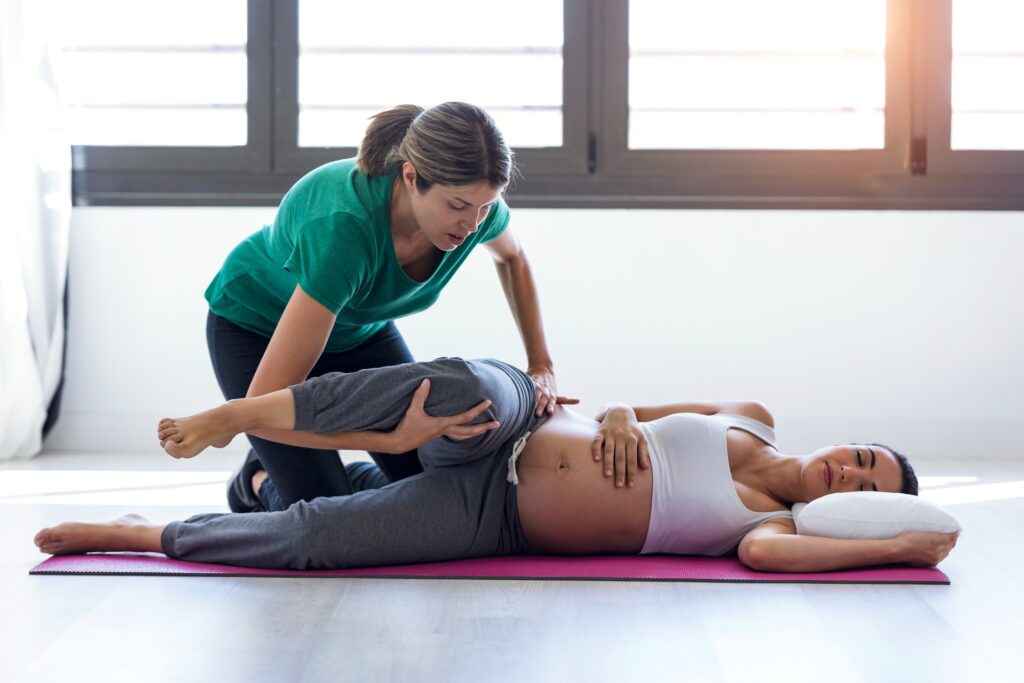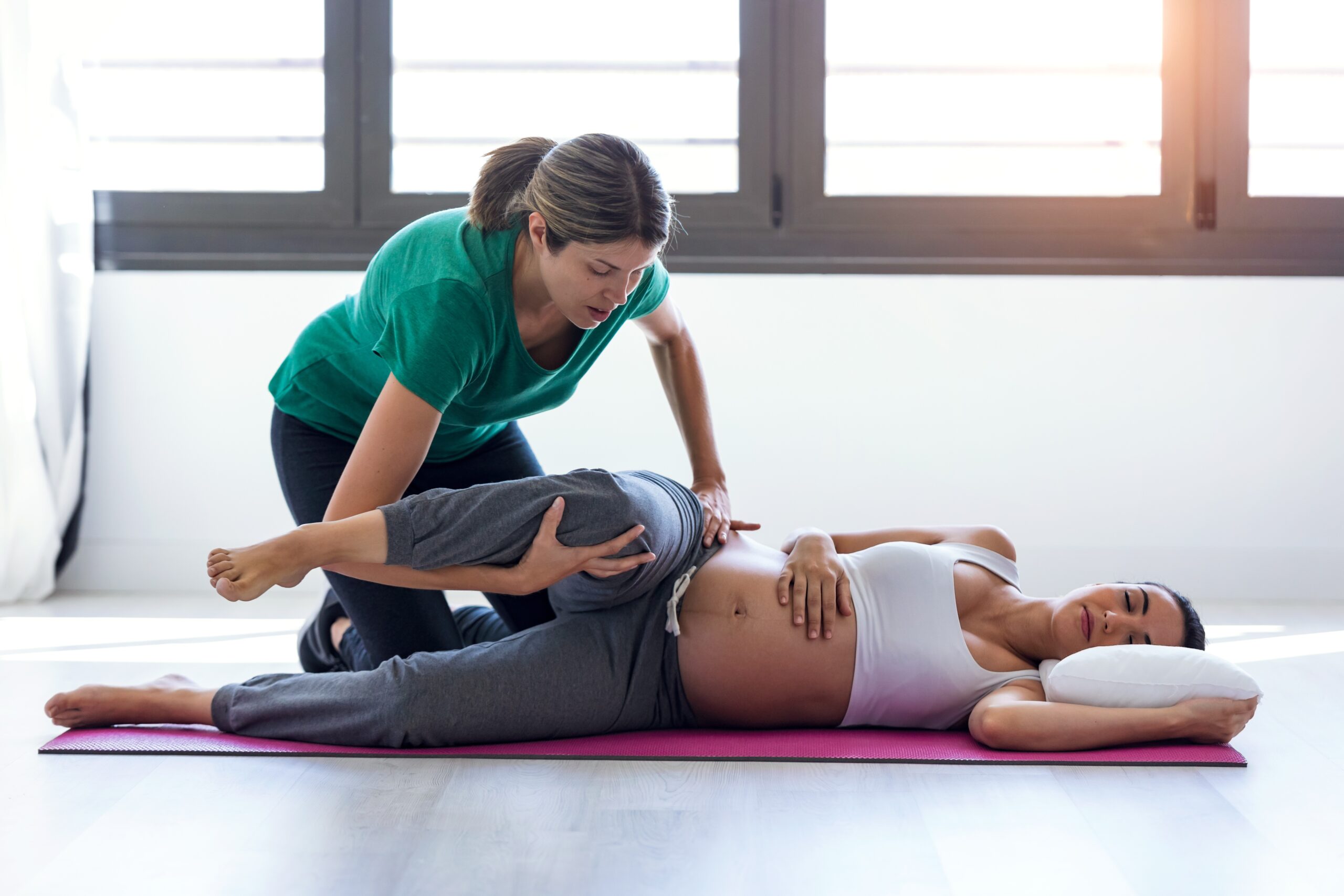The joy of motherhood and the wonder of pregnancy. The highs and lows of pregnancy change. Prenatal physiotherapy steps in to help your body bend, hold, and stay steady. These simple moves help you stay strong, walk better, and feel ready for birth. You don’t need fancy tools—just space and a little time.

1. Pelvic Tilts
Your lower back works hard as your belly grows. That makes it feel sore. Pelvic tilts stretch your back and strengthen your tummy muscles. This move helps your body stand tall and rest easier. You can do this every day. It doesn’t take much time, and it feels great. Many trusted prenatal physiotherapy routines begin with this simple exercise. You can also ask a physiotherapist to show you how to do it right.
Ease Tension in the Lower Back
- Lean your back against a wall.
- Bend your knees a little
- Push your hips forward slowly.
- Count to five, then relax.
Take deep breaths as you tilt. Let your muscles stretch and settle.
2. Cat-Cow Stretch
As your baby grows, your back may feel tight and stiff. The cat-cow stretch helps you bend and stretch your spine gently. This makes you feel lighter and helps you breathe deeper. It also lets your shoulders and neck loosen. This move fits in many pregnancy body care plans. You can do it at home or with help from a physiotherapist.
Boost Spine Flexibility and Control
- Start on hands and knees.
- Round your back like a cat.
- Then lift your head and drop your belly like a cow.
- Move back and forth slowly.
Breathe as you move. Let each stretch make your back feel smooth and soft.
3. Kegels
Your pelvic floor holds your organs inside and supports your baby. During pregnancy, these muscles stretch and tire. Kegels wake up those muscles. They help you stay dry when you sneeze or laugh. They also help you heal faster after birth. You don’t need to move much for this exercise. Many mums talk to a physiotherapist near me to learn the right way. These moves are part of every trusted pregnancy body care plan.
Strengthen Muscles for Birth and Recovery
- Sit or lie in a quiet place.
- Pretend you are stopping your pee.
- Squeeze the muscles tight.
- Hold for five seconds, then rest.
Squeeze gently, not hard. Feel the lift and the drop. That’s how you build strength.
4. Wall Squats
Your legs carry more weight every week. Wall squats help you grow strong in your thighs, hips, and bottom. They also help you stand longer and walk steadier. This move needs only a wall and your body. Start with just a few squats. Add more as your muscles grow stronger. This exercise sits in many pregnancy body care routines. A physiotherapist can guide you and keep your form safe.
Build Endurance in Hips and Thighs
- Stand with your back against a wall.
- Step your feet forward.
- Slide down into a seat shape.
- Hold for five seconds, then stand.
Don’t rush. Feel your legs press and lift. They grow stronger with each squat.
5. Side-Lying Leg
Your hips hold more weight each day. That can make walking feel strange. Side-lying leg lifts make your hips, thighs, and belly stronger. They help your body stay balanced. This move feels easy and works well during all stages of pregnancy. Many trusted pregnancy body care experts add this to every plan. A quick talk with a physiotherapist can help you do it safely.
Balance Muscle Strength on Both Sides
- Lie on your side with your legs straight.
- Keep your head comfy with a pillow.
- Raise your top leg slowly.
- Lower it without letting it drop.
Move with care. You’ll feel your side muscles wake up and do their job.
Why Prenatal Physiotherapy Helps
Moves that build strength, ease joints, and lighten your body during pregnancy.” You feel more in control as you move, stand, and rest. Many mums say they sleep better and feel less pain. If you want help, find a physiotherapist. They’ll make a plan that fits you. A trusted prenatal physiotherapy provider knows how to guide your changing body.
Benefits include:
- Fewer backaches and sore joints
- Easier breathing and better posture
- Less swelling in feet and hands
- Shorter healing after birth
You don’t need to do it all. Just a few steps each day make a big difference.
How to Do It Safely
You can start moving early in your pregnancy. Or begin later—it still helps. Ask your doctor if you feel unsure. Then take it slow and stay kind to your body. If you want help, find a physiotherapist near me who works with mums-to-be. A trusted pregnancy body care plan shows you safe ways to stretch and build strength.
Start Early and Move Smart
- Wear loose, comfy clothes.
- Keep water nearby
- Use a soft mat or towel.
- Stop if anything hurts.
Move with care, not force. Let your breath and body guide you. That’s the best way to grow strong.
Belly Breathing Basics
As your baby grows, your lungs press upward and stretch tight. That makes deep breaths harder. Deep breathing calms the body and fuels strong muscles. You can use this breathing trick during labour too. Many mums explore it through pregnancy body care to stay steady and feel ready. Practice it in bed, on the couch, or while sitting with your feet up.
Try Belly Breathing with These Easy Steps
- Sit or lie in a quiet spot.
- Rest one hand on your chest and the other on your belly.
- Keep your chest still while your belly lifts.
- Blow the air out slowly through your mouth
This breath helps your body melt tension and your mind feel light.
Final Thought
The periods of these 9 months have different phases, during this time your baby develops and your body changes. Rest and care that recharge your body for change.” Use prenatal physiotherapy to find safe ways to stretch, carry, and steady your body during pregnancy.
Frequently Asked Questions
Q1: When should I start doing these exercises during pregnancy?
Concerned with your doctor first, notice what your body says, and begin gently. Grow the habit slowly and stick with it every day.
Q2: Can I do these exercises every day?
Yes, you can. These exercise gives you the best result when you adopt them in your daily life. Even short sessions help. Stretching regularly makes you active , when your body ask for rest take rest also.
Q3: What should I do if an exercise feels painful?
Are you feeling pain when doing exercise? It means your body is not ready for this exercise. Shift to a softer move or ask someone trained to guide you with safer steps.

